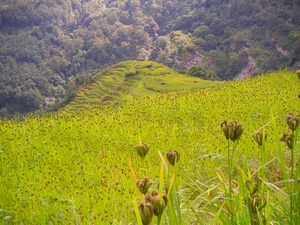Millet
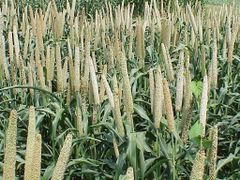
The millets are a group of small-seeded species of cereal crops or grains, widely grown around the world for food and fodder. They do not form a taxonomic group, but rather a functional or agronomic one. Their essential similarities are that they are small-seeded grasses grown in difficult production environments such as those at risk of drought. They have been in cultivation in East Asia for the last 10,000 years.[1]
Contents |
Millet varieties
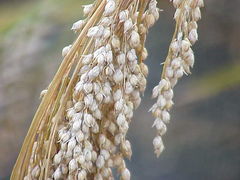
The millets include species in several genera, mostly in the subfamily Panicoideae, of the grass family Poaceae. Of the major and minor millets (not including those plants sometimes called millet) all of the species are in the tribe Paniceae of the subfamily Panicoideae except for finger millet. The most widely cultivated species in order of worldwide production[2] are
- Pearl millet (Pennisetum glaucum)
- Foxtail millet (Setaria italica)
- Proso millet, common millet, broom corn millet, hog millet or white millet (Panicum miliaceum)
- Finger millet (Eleusine coracana)
Minor millets include
- Indian barnyard millet or Sawa millet (Echinochloa frumentacea)
- Japanese barnyard millet (Echinochloa esculenta)
- Kodo millet (Paspalum scrobiculatum)
- Little millet (Panicum sumatrense)
- Guinea millet (Brachiaria deflexa = Urochloa deflexa)
- Browntop millet (Urochloa ramosa = Brachiaria ramosa = Panicum ramosum)
Teff (Eragrostis tef) and fonio (Digitaria exilis) are also often called millets, as more rarely are sorghum (Sorghum spp.) and Job's Tears (Coix lacrima-jobi).
History
Specialized archaeologists called palaeoethnobotanists, relying on data such as the relative abundance of charred grains found in archaeological sites, hypothesize that the cultivation of millets was of greater prevalence in prehistory than rice,[3] especially in northern China and Korea. It was millets, rather than rice, that formed important parts of the prehistoric diet in Chinese Neolithic and Korean Mumun societies. Broomcorn (Panicum miliaceum) and foxtail millet were important crops beginning in the Early Neolithic of China. For example, some of the earliest evidence of millet cultivation in China was found at Cishan (north) and Hemudu (south). Cishan dates for common millet husk phytoliths and biomolecular components have been identified around 8300–6700 BC in storage pits along with remains of pit-houses, pottery, and stone tools related to millet cultivation.[1] Evidence at Cishan for foxtail millet dates back to around 6500 BC.[1] A 4,000-year-old well-preserved bowl containing well-preserved noodles made from foxtail millet and broomcorn millet was found at the Lajia archaeological site in China.[4]
Palaeoethnobotanists have found evidence of the cultivation of millet in the Korean Peninsula dating to the Middle Jeulmun pottery period (c. 3500–2000 BC) (Crawford 1992; Crawford and Lee 2003). Millet continued to be an important element in the intensive, multi-cropping agriculture of the Mumun pottery period (c. 1500–300 BC) in Korea (Crawford and Lee 2003). Millets and their wild ancestors such as barnyard grass and panic grass were also cultivated in Japan during the Jōmon period some time after 4000 BC (Crawford 1983, 1992).
Millet made its way from China to the Black Sea region of Europe by 5000 BC.[5] The cultivation of common millet as the earliest dry crop in East Asia has been attributed to its resistance to drought[1] and this has been suggested to have aided its spread.[5]
Major research on millets is carried out by the International Crops Research Institute for the Semi-Arid Tropics in Andhra Pradesh, India, and by the USDA-ARS at Tifton, Georgia, USA.
Production
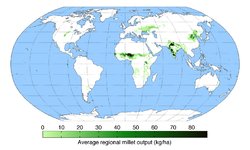
India is the world's main producer of millet.
| Top ten millet producers — 2007 | ||||
|---|---|---|---|---|
| Country | Production (Tonnes) | Footnote | ||
| 10,610,000 | * | |||
| 7,700,000 | * | |||
| 2,781,928 | ||||
| 2,101,000 | F | |||
| 1,104,010 | ||||
| 1,074,440 | F | |||
| 792,000 | * | |||
| 732,000 | ||||
| 550,000 | * | |||
| 500,000 | F | |||
| World | 31,875,597 | A | ||
| No symbol = official figure, P = official figure, F = FAO estimate, * = Unofficial/Semi-official/mirror data, C = Calculated figure A = Aggregate (may include official, semi-official or estimates); |
||||
Current uses of millet
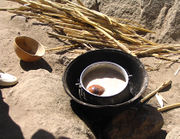
As a food source
Millets are major food sources in arid and semi-arid regions of the world, and feature in the traditional cuisine of many others. In Western India, Sorghum (called "Jowar", "Jwaarie" or "Jondhahlaa" in Gujarati, HIndi and Marathi) has been commonly used with millet flour (called "Bajari" in Western India) for hundreds of years to make the local staple hand rolled (that is, without a rolling pin) flat bread (called "Rotla" in Gujarati or "Bhakri" in Marathi or Rotti in other languages. Another cereal grain popularly used in rural and poor people to consume as staple in the form of roti or other forms is called Ragi in Karnataka or Naachanie in Maharashtra, with the popularly made Ragi Rotti in Kannada). Ragi Mudde is a popular meal in Southern India. Ragi is dark like rye but rougher in texture.
Millet porridge is a traditional food in Russian , German and Chinese сuisines. In Russia it is eaten sweet (with milk and sugar added at the end of cooking process) or savoury with meat or vegetable stews. In China it is eaten without milk or sugar, frequently with beans, sweet potato, and / or various types of squash. In Germany it is also eaten sweet (boiled in water with apples added during the boiling process and honey added during the cooling process).
People with celiac disease can replace certain gluten-containing cereals in their diets with millet.
Millets are also used as bird and animal feed.
Alcoholic beverages
Millets are traditionally important grains used in brewing millet beer in some cultures, for instance by the Tao people of Orchid Island, Taiwan, and, along with sorghum, by various peoples in East Africa. It is also the base ingredient for the distilled liquor rakshi in Nepal and the indigenous alcoholic drink of the Sherpa, Tamang, and Limbu people, tongba, in Eastern Nepal. In Balkan countries, especially Romania and Bulgaria, millet is used to prepare the fermented drink boza.
Other uses
Millet, along with birdseed, is commonly used as fillings for juggling beanbags.
Millet is widely popular as a treat/food for the domesticated pet Parakeet/Budgerigar.
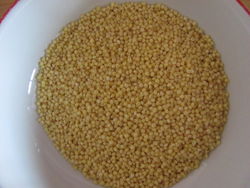
Nutrition
The protein content in millet is very close to that of wheat; both provide about 11% protein by weight.
Millets are rich in B vitamins, especially niacin, B6 and folic acid, calcium, iron, potassium, magnesium, and zinc. Millets contain no gluten, so they are not suitable for raised bread. When combined with wheat, (or xanthan gum for those who have celiac disease), they can be used for raised bread. Alone, they are suited for flatbread.
As none of the millets are closely related to wheat, they are appropriate foods for those with celiac disease or other forms of allergies/intolerance of wheat. However, millets are also a mild thyroid peroxidase inhibitor and probably should not be consumed in great quantities by those with thyroid disease.
Preparation
The basic preparation consists in washing the millet and toasting it while moving until one notes a characteristic scent. Then five measures of boiling water for each two measures of millet are added with some sugar or salt. The mixture is cooked covered using low flame for 30–35 minutes.
Notes
- ↑ 1.0 1.1 1.2 1.3 Lu H, Zhang J, Liu KB, Wu N, Li Y, Zhou K, Ye M, Zhang T, Zhang H, Yang X, Shen L, Xu D, Li Q. (2009). Earliest domestication of common millet (Panicum miliaceum) in East Asia extended to 10,000 years ago. Proc Natl Acad Sci U S A. 106: 7367–7372 PubMed
- ↑ "Annex II: Relative importance of millet species, 1992-94". The World Sorghum and Millet Economies: Facts, Trends and Outlook. Food and Agriculture Organization of the United Nations. 1996. ISBN 92-5-103861-9. http://www.fao.org/docrep/W1808E/w1808e0l.htm.
- ↑ Tarannum Manjul (January 21, 2006). "Millets older than wheat, rice: Archaeologists". Lucknow Newsline. http://cities.expressindia.com/local-news/fullstory.php?newsid=166480. Retrieved 2008-04-14.
- ↑ "Oldest noodles unearthed in China". BBC News. 12 October 2005. http://news.bbc.co.uk/2/hi/science/nature/4335160.stm.
- ↑ 5.0 5.1 Lawler, A. (2009). Bridging East and West: Millet on the move. Science, 942-943. doi:10.1126/science.325_940
References
- Crawford, Gary W. (1983). Paleoethnobotany of the Kameda Peninsula. Ann Arbor: Museum of Anthropology, University of Michigan. ISBN 0932206956.
- Crawford, Gary W. (1992). "Prehistoric Plant Domestication in East Asia". In Cowan C.W., Watson P.J. The Origins of Agriculture: An International Perspective. Washington: Smithsonian Institution Press. pp. 117–132. ISBN 0874749905.
- Crawford, Gary W. and Gyoung-Ah Lee (2003). "Agricultural Origins in the Korean Peninsula". Antiquity 77 (295): 87–95.
External links
- "Millets". Alternative Field Crops Manual. http://www.hort.purdue.edu/newcrop/afcm/millet.html.
- "Vegetarians in Paradise: Millet History, Millet Nutrition, Millet Recipe". http://www.vegparadise.com/highestperch29.html.
|
|||||
|
||||||||||||||||||||
